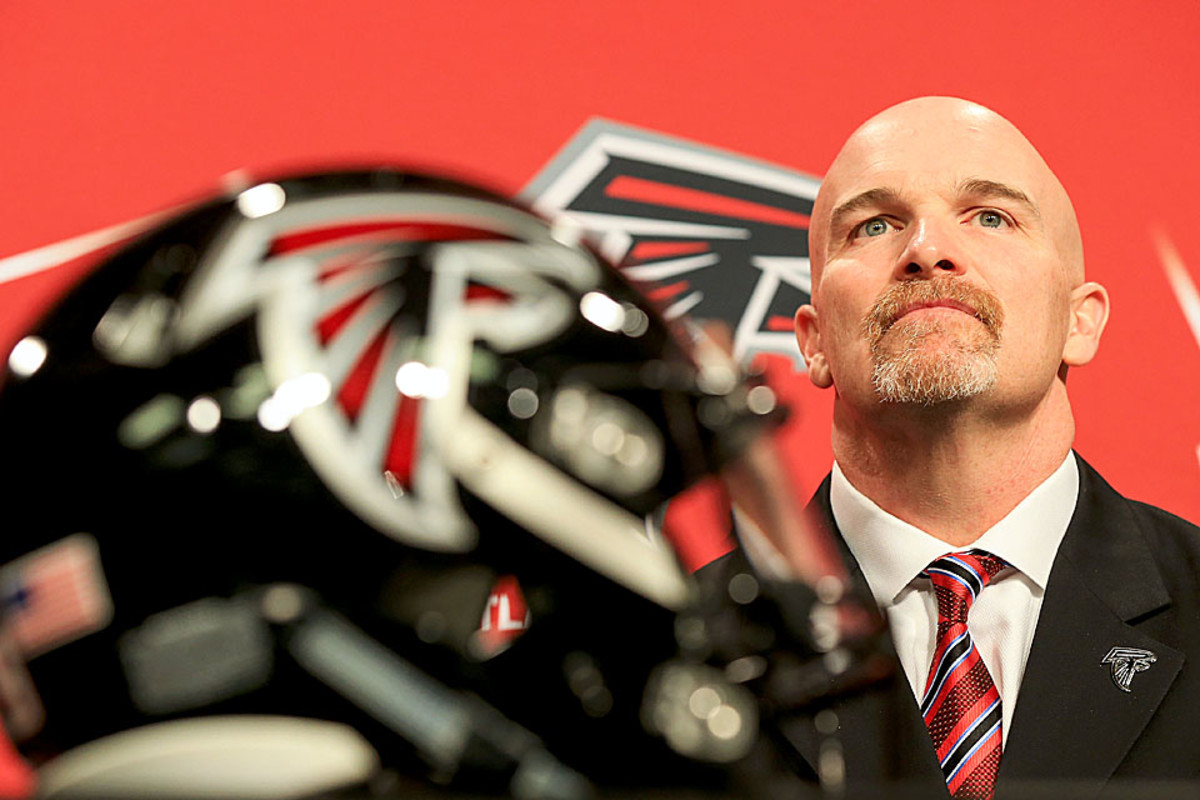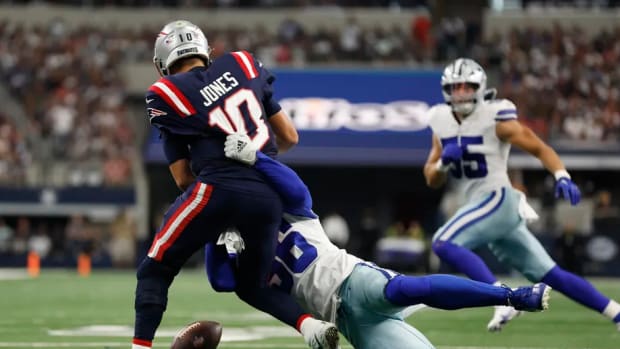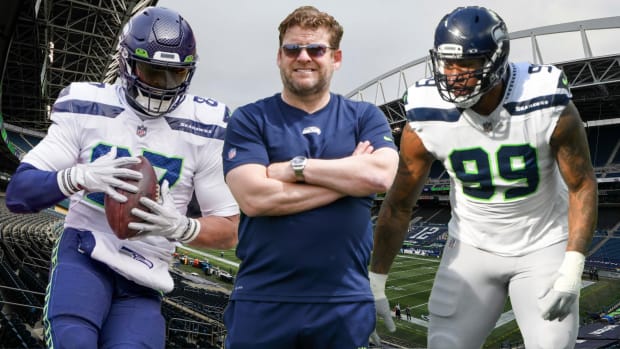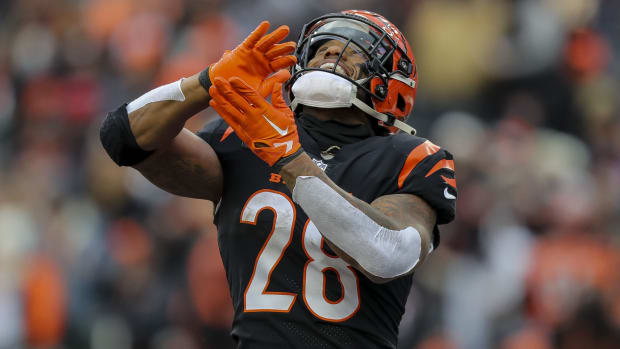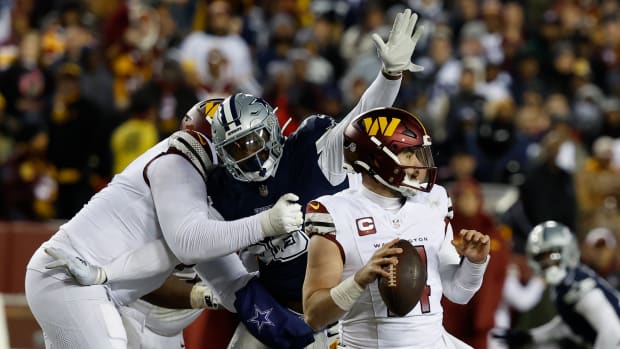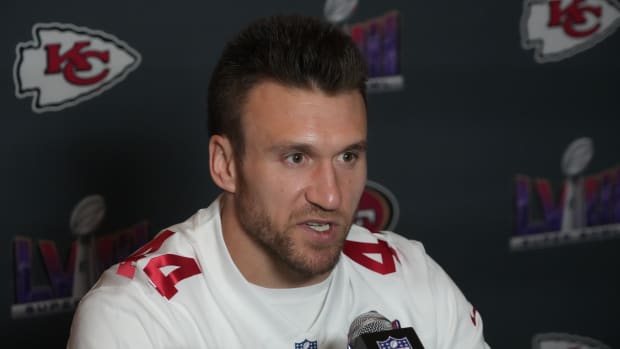T-Minus 35 Days: Atlanta’s Perfect Pass Rusher
How many first-time head coaches walk into a job with final say over the 53-man roster? It’s impossible to say; teams don’t always share that sort of information. Anecdotally, Nick Saban comes to mind. And now Dan Quinn. Thomas Dimitroff and Scott Pioli will run the Falcons draft with input from a first-year head coach who wrote up scouting reports on defensive prospects in Seattle.
It just so happens that Atlanta’s biggest need lines up perfectly with Quinn’s expertise.
“It’s the toughest defensive position to evaluate, and it’s what’s nearest and dearest to my heart,” he says. “Pass rusher.”
Pass rushers in the Seattle 4-3 defensive mold come in different shapes and sizes. The LEO is a kind of hybrid outside linebacker/defensive end whose main role is to rush the passer, but who can also drop and give the effect of a 3-4 defense. The opposite end is more traditional, a la Michael Bennett. Of Atlanta’s two penciled-in defensive ends right now, Tyson Jackson is better suited to play tackle, and free-agent signee Adrian Clayborn has missed 28 games over four NFL seasons. As we count down to a stacked draft class of rushers, what is Quinn looking for?
Randy Gregory’s positive test at the combine could jeopardize his status as a top pick. (Jeff Haynes/SI)
“Initial speed,” Quinn says. “You have to be able to beat someone off the ball who is going to be stronger than you. Then you have to be able to use the length—length is important—and have the relentlessness to finish.
“Then with the mental makeup, with both cornerbacks and rushers, you have to be a relentless fighter. There’s a 330-pound bear in front of you, and you just have to figure out a way to beat him. You have to be fast enough to run with the running backs and tight ends and strong enough to fight a bear. You have to be a unique dude.”
A length prerequisite would rule out short-armed Clemson linebacker Vic Beasley, but he has the speed and agility to play LEO. Florida OLB Dante Fowler isn’t long either but has shown versatility and played for Quinn at Florida in 2012. Randy Gregory and Shane Ray look like ideal LEO candidates, with relentlessness and excellent timed speed, though Gregory's admission that he failed a test for marijuana at the combine will kill his prospects with some teams.
Quinn cautions against overvaluing metrics (which Falcons general manager Thomas Dimitroff has called a “determining factor in separating players” in the past). “I lean towards the film,” Quinn says. “It’s so much easier to predict what the guy can do based on tape. If you rely too heavily on a number you can get swayed. Now, certain measurables are valuable. We can’t necessarily tell how long a guy is based on the tape.”
Quinn obviously wouldn’t share which of the available rushers he prefers, but he told a group of reporters Wednesday at the owners meetings he liked eight of them. My best guess for the Falcons’ target with the eighth pick: Randy Gregory, if Atlanta is satisfied with his explanation for the positive test.
Things You Need To Know About The Draft
I’ll do two top-10 mock drafts between now and draft day: Today’s focuses on what teams ought to do (next month, I’ll guess what teams will do).
1. Tampa Bay Buccaneers: Leonard Williams, DT/DE, USC
Williams is the best player available in the draft, regardless of position, and as close to a sure thing as there is in 2015. He can play end or tackle, both needs in Tampa. If I’m Lovie Smith, I sit on the QB choice during a down year and pair Williams with three-time All-Pro Gerald McCoy. Terrifying.
The Prospects
Leonard Williams: Our Andy Benoit sat down for a film session with the draft's best defensive player. Here's what Leonard Williams taught him.Brandon Scherff: The draft's best—and nastiest—blocker is a modern-day Paul Bunyan.
2. Tennessee Titans: Brandon Scherff, OT, Iowa
The temptation here would be to draft Jameis Winston. Don’t do it. I’m of the firm belief that Winston will be an underwhelming pro if paired with a decent offensive line, and a disaster with a bad one (like Tampa’s or Tennessee’s). Scherff will be a major building block for whichever team drafts him, be it at guard or right tackle, where he would likely start in Tennessee.
3. Jacksonville Jaguars: Amari Cooper, WR, Alabama
Feed Blake Bortles. He’s the guy, and he needs wide receivers who can contribute immediately. Enter Cooper, an outstanding route-runner with experience in a pro scheme. Gus Bradley will be tempted to take one of the pass rushers here, but it would be a mistake.
4. Oakland Raiders: Dante Fowler Jr., OLB, Florida
Address Oakland’s biggest need with the best available player, pairing the versatile Fowler with all-around havoc-maker Khalil Mack. Fowler can stand up or play the edge as a system-agnostic 260-pounder, but hefits nicely in Oakland’s 4-3.
5. Washington: Randy Gregory, DE, Nebraska
He’s a popular mock draft choice for Washington for a good reason: Gregory specializes in getting after the QB and does so with a unique fervor. Fowler would’ve been a nice fit here for a struggling run defense, but Gregory will do the trick. The failed marijuana test raises questions about his decision-making, but many teams realize that pot use is not uncommon among players, and it's not necessarily a deal-breaker.
6. New York Jets: Jameis Winston, QB, Florida State
What a coup this would be for Jameis. He gets behind an aging but still solid offensive line, with Brandon Marshall and Eric Decker as his best weapons. If he’s learned anything in the past two years, it’s how to handle the kind of media scrutiny New York would bring.
7. Chicago Bears: Shane Ray, DE, Missouri
If the defense doesn’t get better the city will rise up and push this new front office into Lake Michigan. The Bears need linebackers more than anything, but it’s always smart to go best available (within reason) early in the first round. Ray is an elite talent who fell down some media draft boards after his sluggish combine. I’ll trust the tape.
8. Atlanta Falcons: Vic Beasley, OLB, Clemson
Fowler, Gregory and Ray are all gone. Beasley is not a big man nor a run-stuffer, but he plays fast and has shown the requisite agility to drop into coverage. Quinn gets a project, and Beasley gets a first-class coach for his position.
9. New York Giants: Danny Shelton, DT, Washington
It’s not their biggest need, but the high-motor hulk from Washington would start right away and have a big impact. He’s the best run-stuffer available, provided the top four defensive ends are off the board, and a great fit in Steve Spagnuolo’s defense.
10. St. Louis Rams: Kevin White, WR, West Virginia
I could’ve sent him to Oakland, or Jacksonville, but he slips to St. Louis and new quarterback Nick Foles, who would no longer have to fret over Brian Quick and his injured shoulder or 5-8 Tavon Austin as his No. 2 wide receiver.
Photo by John Grieshop/Getty Images
Draft Season Do-Over
Every week, we’ll ask a current NFL player what he would have done differently in the time between his final collegiate game and the day he was drafted…
Darqueze Dennard, Cincinnati Bengals (2014, 24th overall). “I thought I was thoroughly prepared coming into camp. I wanted to come in and be the best and have a real shot at being productive. If I could do it again, I would take a break at some point in there—maybe a week off before the draft—because it’s a really long season. Dial it back and relax for a week.”
Better Know a Prospect
Photo by Rick Bowmer/AP
Fresno State defensive tackle and potential late-round pick Tyeler Davison (6-2, 316) played in more than 40 games during his four seasons and was an all-conference performer as early as his sophomore season. His long arms augment decent height, which makes his 32 bench-press reps at the combine all the more impressive.
The MMQB: One of your strengths has been the ability to play almost every snap. Did you always have great stamina?
Davison: I remember getting super tired when I was in high school playing both ways, and then with wrestling you have to run miles during practice for conditioning, and I feel like since then, it made me more able to fight through being tired.
The MMQB: Greatest benefit of wrestling for your football career?
Davison: The biggest thing wrestling teaches you is mental toughness. When you’re wrestling you have to hold yourself accountable, because it’s nothing but your preparation and hard work. Nobody wrestles for you. You can’t hide. Also: flexibility, balance, being able to compete while tired.
The MMQB: It’s been written that you were disappointed in a move to end that came early in the season and it showed on tape. True?
Davison: I can tell you it wasn’t true. I played end the first few games, and I feel like I got progressively better. Before the first week against USC, I sprained my ankle 10 days prior and sat out of practice for a week, which brought my conditioning down and didn’t help in learning a new position.
Quote of the Week
“It’s funny how people make such a big deal out of the combine and pro days, and you have all the TV coverage. The Senior Bowl practices and the game itself should have a bigger impact than the combine, but they don’t. We should be saying, You should’ve seen this guy play football at the Senior Bowl, notYou should’ve seen him running at the combine.”
—Falcons coach Dan Quinn, to The MMQB
Dan Quinn, you so crazy.
Stat of the Week
Seven running backs invited to the veteran combine over the weekend in Phoenix, averaging 25.5 years in age and each with experience on NFL rosters, averaged a 4.84-second 40.
There are two ways to look at this: (1) It could be that after just three or four years as a running back in the NFL, enough damage is inflicted on the body to add .4 seconds to the average running back’s 40 time. And (2) potentially, guys who spend an offseason doing football-specific training and not prepping for the 40-yard dash are uniquely unprepared, rendering any comparison to their rookie counterparts unfair.
I think there’s some truth to both of those points.
Scorching Hot Take of the Week
Courtesy of Breshad Perriman’s pro day 40 and the ensuing #draftwitter meltdown.
CUZ ITS THAT SERIOUS GUYS And the Sober Take of the Week...
Follow The MMQB on Facebook, Twitter and Instagram.
[widget widget_name="SI Newsletter Widget”]
































